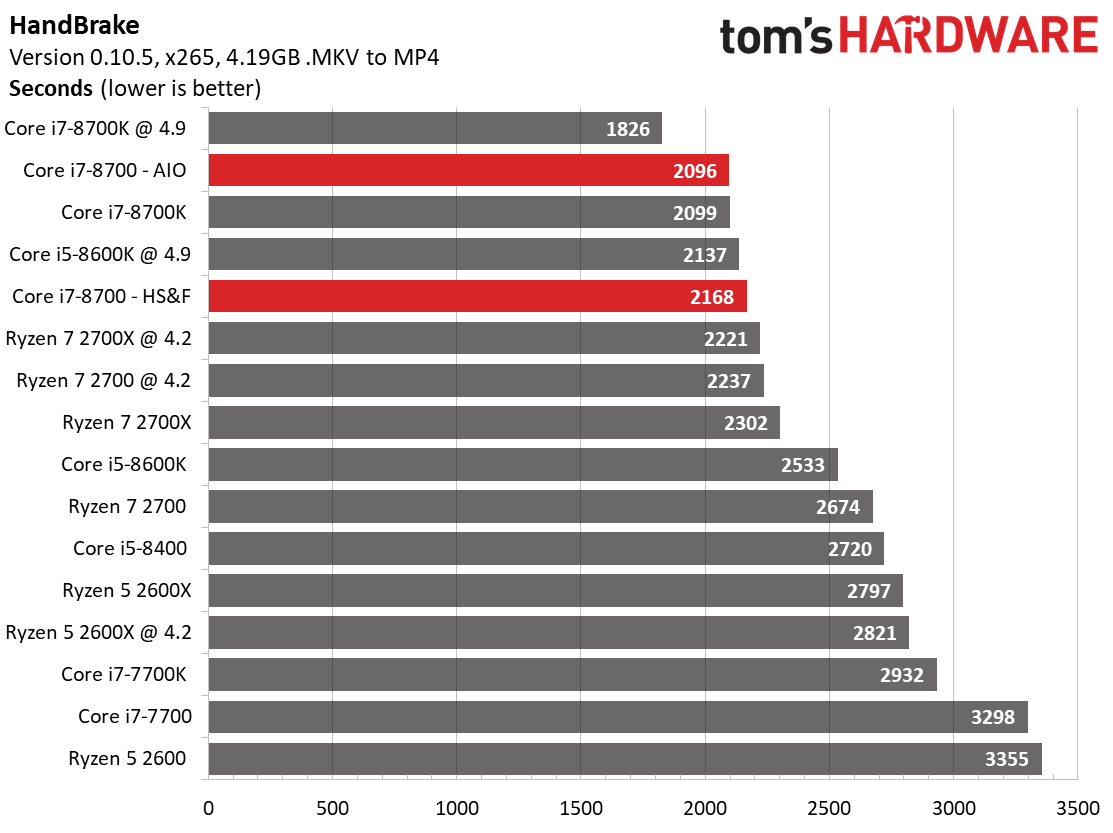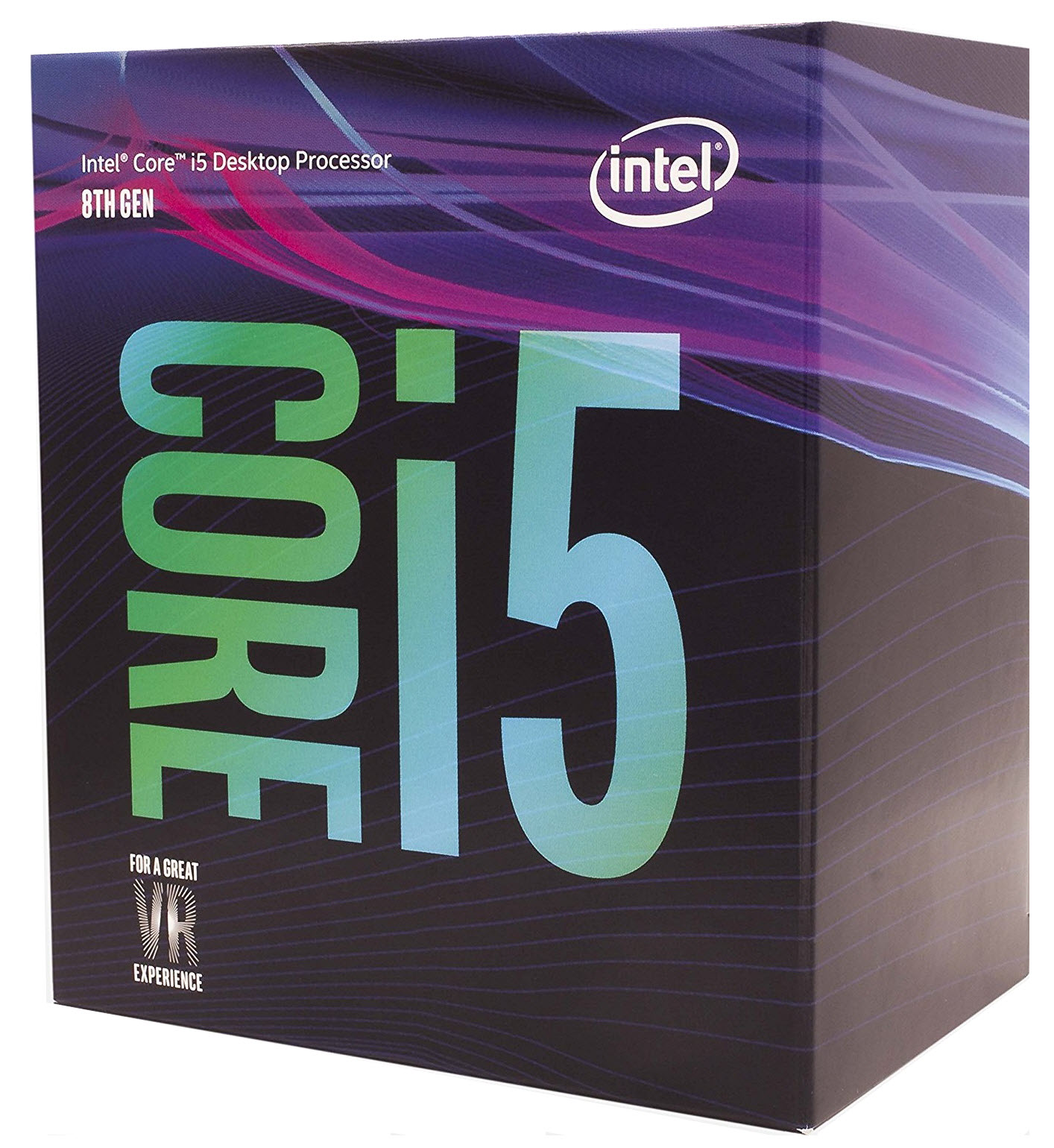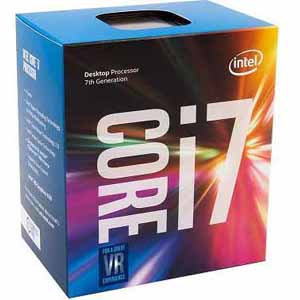Intel Core i7-8700 Review: Stock Cooler Falls Flat
Why you can trust Tom's Hardware
The Stock Cooler Dilemma & Test Setup
The Stock Cooler Dilemma
Intel ships its multiplier-locked CPUs with basic thermal solutions. Although they are notoriously flimsy and usually pretty noisy, they've proven sufficient for cooling previous-generation models. That changes with Core i7-8700.
In the not-too-distant past, Intel's stock heat sink employed a copper core. More recently, however, the company switched to all-aluminum designs. That means Core i7-8700 comes with the same cooler as quad-core Kaby Lake-based Core i5s.
Frankly, we're surprised that Intel carried over the same heat sinks from those seventh-generation Core CPUs. Despite the -8700's 65W TDP, it's still based on a notably more complex die.
On paper, the -8700's 65W TDP fits nicely within the low-profile cooler's 73W rating. But remember that Intel specs the CPU's thermal design power according to its base frequency. Its chips actually exceed the TDP when they dynamically increase voltage and frequency through their Turbo Boost algorithms. As noted on Intel's Turbo Boost 2.0 informational page:
Note: Intel Turbo Boost Technology 2.0 allows the processor to operate at a power level that is higher than its TDP configuration and data sheet specified power for short durations to maximize performance.
According to our measurements, Core i7-8700 peaks at up to 126W during taxing all-core workloads. With that data in-hand, the stock cooler does appear insufficient.
While Intel guarantees base frequencies during normal operation, the company doesn't make promises about Turbo Boost clock rates because its processors only shift to higher P-states (pre-defined frequencies and voltages) when they're running below certain temperature, voltage, power, and current limits. Above them, the opportunistic algorithms are reigned in to keep the CPU in-spec.
Get Tom's Hardware's best news and in-depth reviews, straight to your inbox.
As a general rule, Turbo Boost targets lower frequency bins as more cores become active. Intel does still advertise its maximum single-core clock rates, but it no longer divulges the multi-core clock rates (even though you can expose them through the company's XTU software).
| Frequencies | Base | 1 | 2 | 4 | 6 |
| Intel Core i7-8700K | 3.7 GHz | 4.7 GHz | 4.6 GHz | 4.4 GHz | 4.3 GHz |
| Intel Core i7-8700 | 3.2 GHz | 4.6 GHz | 4.5 GHz | 4.4 GHz | 4.3 GHz |
We've seen lots of speculation that Intel stopped disclosing multi-core Turbo Boost frequencies with Coffee Lake-based processors because its stock heat sink and fan couldn't fully facilitate those clock rates. Sure enough, a quick online search reveals several reports from owners claiming that their Core i7-8700s hit the maximum safe temperature of 100°C (TJ Max) during extended workloads. Once the processor reaches TJ Max, it throttles back voltage and frequency (along with power and heat) as a protection mechanism. Of course, throttling also results in lower performance.
Measuring The Impact
To investigate the claims, we observed a Core i7-8700 and its stock cooler during our x265 HandBrake benchmark. This real-world application is optimized to utilize all available cores. Moreover, it employs AVX instructions, which tend to increase power consumption considerably. We opened AIDA's system stability test window to monitor our -8700 during the workload.
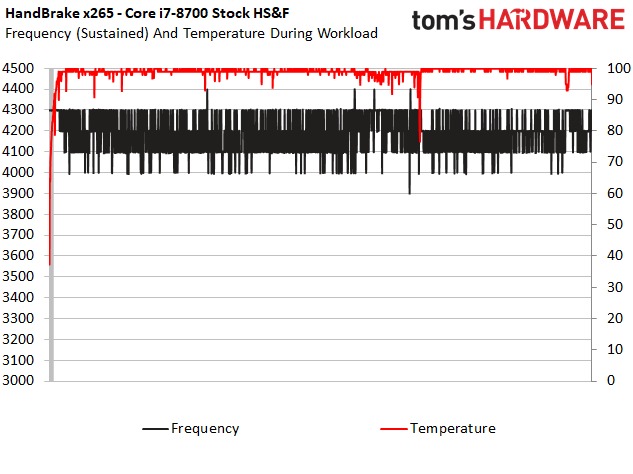
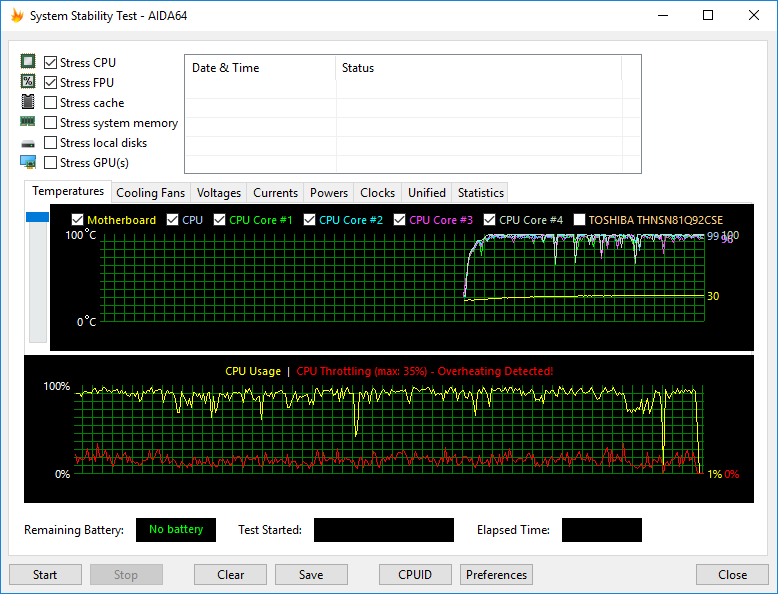
As you can see in the second slide, Intel's cooler was quickly overwhelmed, causing the processor to repeatedly bounce off of its 100°C temperature limit and throttle performance to protect itself (charted in red in the lower window).
With the bundled fan manually set to 100% duty cycle, we logged frequency throughout our test run (first album image). Even with the thermal solution working as hard as possible, the -8700 regularly throttled back from its 4.3 GHz all-core bin into lower ranges.
We also monitored VRM temperature during the test to ensure our motherboard's power delivery subsystem wasn't responsible for the throttling. Those measurements landed within the range we expected.
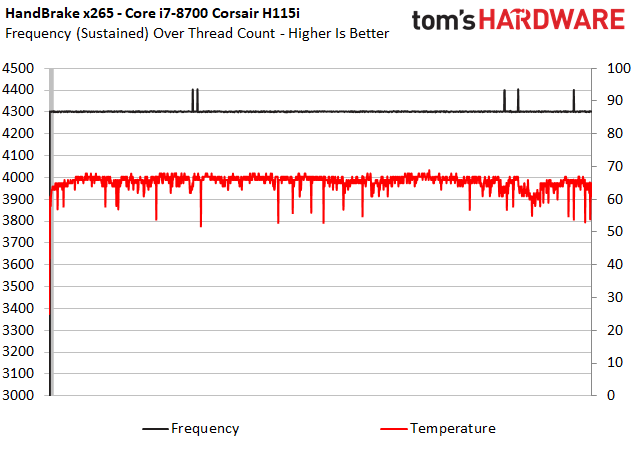

Next, we ran the same test using a beefy Corsair Hydro Series H115i "Extreme Performance" all-in-one liquid-cooler. Manually cranking the two 140mm fans and pump up to 100% helped ensure that thermal output had no impact on our test results.
The difference is night and day. Intel's Core i7-8700 never exceeded 67°C, and the processor's frequency remained at a pleasingly-constant 4.3 GHz (though we did notice a few spikes higher during brief periods of lighter utilization). AIDA's system monitor confirmed that the CPU didn't throttle. Again, we see that our motherboard's power delivery subsystem satisfied the Core i7-8700's power and current requirements.
Comparing the difference between Intel's stock cooler (HS&F) and the all-in-one makes it clear that thermals clearly affect the -8700's performance. Turbo Boost is clearly designed to minimize the impact of thermal throttling: we only observe a 72-second delta over the course of our ~35-minute test.
A mere 3.4% separating those results may seem insignificant, but remember that we tested these configurations on an open test bench. A closed case would change the outcome almost assuredly. Also, we benchmarked at maximum fan settings, generating quite a bit of noise. It's far more common to use the motherboard's default fan curve, or to dial in an optimized fan profile that ramps up gradually. Unfortunately, those algorithms don't respond to control temperature fast enough to mitigate wild spikes and dips. As a result of the normal delay in fan speed adjustments, plus the less-than-ideal airflow in most PC cases, you could see larger slow-downs than what we recorded from a best-case test environment. This doesn't bode well for builders working with small form factors.
We did experiment with various thermal compounds between the stock cooler and heat spreader, but they didn't help much. Thus, we pin the negative outcome of our experimentation on Intel's paltry heat sink and fan combination.
Bear in mind that our benchmarks are run with the stock cooler and Corsair's all-in-one to highlight the difference in thermal performance. Some tests are short, while others take longer to complete. Some are single-threaded, while other are fully parallelized. Thus, the effects of heat influence each result in a unique way. As noted, we kept the fan speed at maximum and tested on an open-air bench, so our results represent a best-case scenario for Intel's stock cooler.
Comparison Products
Test Systems
| Test System & Configuration | |
| Hardware | AMD Socket AM4 (400-Series)AMD Ryzen 7 2700, Ryzen 7 2700X, Ryzen 5 2600X, Ryzen 5 2600 MSI X470 Gaming M7 AC2x 8GB G.Skill FlareX DDR4-3200 @ DDR4-2933, DDR4-3466Intel LGA 1151 (Z370):Intel Core i7-8700K, Core i5-8600K, Core i5-8400, Core i7-8700MSI Z370 Gaming Pro Carbon AC2x 8GB G.Skill FlareX DDR4-3200 @ DDR4-2400, DDR4-2667, DDR4-3466All EVGA GeForce GTX 1080 FE 1TB Samsung PM863 SilverStone ST1500-TI, 1500W Windows 10 Creators Update Version 1703 - All Spectre and Meltdown mitigations |
| Cooling | Corsair H115iIntel stock thermal solution (Core i7-8700) |
MORE: Best CPUs
MORE: Intel & AMD Processor Hierarchy
MORE: All CPUs Content
Current page: The Stock Cooler Dilemma & Test Setup
Prev Page The Core i7-8700 Review Next Page VRMark, 3DMark & AotS: Escalation
Paul Alcorn is the Editor-in-Chief for Tom's Hardware US. He also writes news and reviews on CPUs, storage, and enterprise hardware.
-
AgentLozen This CPU doesn't seem to know who it wants to target. Users who are budget constrained would get better value out of the i5 8400. Demanding gamers and power users should be looking at the i7 8700K or Ryzen 2700X.Reply
In what context does it make sense to buy this CPU? -
RyanTodd1 I brought the processor and so far i havent even begun to hit its limits. I've primarily used it for high end gaming such as the Witcher 3. Very good chip and not too costly either - considering its the new gen. Very happy, only thing is, i wish i have 50 quid more to get the 8700k! Oh well!Reply -
AgentLozen ReplyRyanTodd1 said:Very happy, only thing is, i wish i have 50 quid more to get the 8700k!
I wouldn't sweat it, RyanTodd1. Your graphics card will be the gaming bottleneck before the CPU is.
When I got my first computer in 1997, it came with a Pentium II @ 233MHz. There were 266Mhz and 300Mhz models available at the time that I wished I had instead. Looking back 21 years later, I realized that it never made a difference which one I had. I think you'll feel the same way about your i7 8700. -
Fluffy_Hedgehog Reply21087259 said:oh get real!
stock cooling is always less than prime.
*cough*
https://www.amd.com/system/files/AM4-Wraith-Cooler-Lineup-1920x631.jpg
http://www.relaxedtech.com/reviews/amd/wraith-max-and-wraith-spire-cooler/2
*cough*
you were saying? … yes those are copper plates on those coolers for the 65 and up lineup, yes they do have led and yes thost are actual copper heatpipes on the cooler that comes with the 2700x.
I know a lot of aftermarket coolers that look and perform a hell of a lot worse than what amd puts in the box.
it is only intel that puts half an ounce of third grade aluminium on top of their cpus (because they are too cheap to provide anything worthwhile I suppose …) and expects people to purchase actual cooling after the fact raising the total price of a system significantly. -
Ilya__ Reply21087183 said:This CPU doesn't seem to know who it wants to target. Users who are budget constrained would get better value out of the i5 8400. Demanding gamers and power users should be looking at the i7 8700K or Ryzen 2700X.
In what context does it make sense to buy this CPU?
I don't really agree. The difference between 8700 and 8700k is almost $100 CAD and yet the performance difference at default clocks is very small. So if I am building a machine for someone that will never overclock, save them some money and/or get the 8700 and get a good cooler instead. -
justin.m.beauvais It looks to me that the circumstances where the 8700 overwhelms its cooler are few and far between. For someone looking for great gaming performance, but might not have all the cash needed for an 8700K and cooler, they could get the 8700, not give up much performance, and just get a better cooler later when workloads catch up.Reply
The benchmarks paint a pretty nice picture of the 8700. I believe you, Tom's, when you say that the cooler can be overwhelmed, but your benchmarks don't really seem to indicate much of a loss when/if it is happening, especially in gaming.
Honestly though, why don't they differentiate the designation. Intel should have the 8700 at stock 8700K speeds, but just have the K unlocked. It isn't exactly deserving of the 8700 designation if it is clocked 500MHz lower. Just another thing Intel does that irks me. -
RyanTodd1 Reply21087440 said:RyanTodd1 said:Very happy, only thing is, i wish i have 50 quid more to get the 8700k!
I wouldn't sweat it, RyanTodd1. Your graphics card will be the gaming bottleneck before the CPU is.
When I got my first computer in 1997, it came with a Pentium II @ 233MHz. There were 266Mhz and 300Mhz models available at the time that I wished I had instead. Looking back 21 years later, I realized that it never made a difference which one I had. I think you'll feel the same way about your i7 8700.
Hopefully this is the case, although tech has come a lot further since 1997! I wasnt even born then! :)
-
george_osborne For only ~$50 more I will always go with the unlocked processor. Better base frequency, better turbo and the ability to overclock (if so desired).Reply

